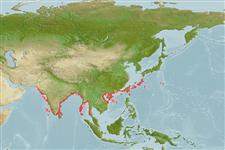Common names from other countries
Elasmobranchii (tubarões e raias) (sharks and rays) >
Carcharhiniformes (Ground sharks) >
Carcharhinidae (Requiem sharks)
Etymology: Glyphis: Tautonymous with Carcharias glyphis Müller & Henle 1839. (See ETYFish); gangeticus: -icus (Gr.) belonging to: Ganges River, India, where Müller and Henle mistakenly thought it occurred. (See ETYFish).
More on authors: Müller & Henle.
Environment: milieu / climate zone / depth range / distribution range
Ecologia
marinhas; Água doce; estuarina demersal; anfídromo (Ref. 51243). Tropical; 30°N - 8°N, 65°E - 143°E
Indo-West Pacific: north Indian Ocean, Indus River outside Karachi, Pakistan to Bangladesh, Myanmar, Thailand and Borneo.
Tamanho / Peso / Idade
Maturity: Lm ? range ? - ? cm
Max length : 204 cm TL macho/indeterminado; (Ref. 244)
Biology poorly known. But its minute eyes suggest that it may be adapted to turbid water with poor visibility, as in large tropical rivers and muddy estuaries. Newborn specimens are from 56 to 61 cm long. Viviparous (Ref. 50449). Its notoriety may have stemmed from its widespread confusion with C. leucas. But this species is potentially dangerous as well because of its size and large teeth, though its reputation as a man-eater is still unproven.
Ciclo de vida ou comportamento de acasalamento
Maturidade | Reprodução | Desova | Ovos | Fecundidade | Larvas
Viviparous, placental (Ref. 50449). Distinct pairing with embrace (Ref. 205).
Compagno, L.J.V., 1984. FAO Species Catalogue. Vol. 4. Sharks of the world. An annotated and illustrated catalogue of shark species known to date. Part 2 - Carcharhiniformes. FAO Fish. Synop. 125(4/2):251-655. Rome: FAO. (Ref. 244)
Status na Lista Vermelha da UICN (Ref. 130435)
Ameaça para os humanos
Traumatogenic
Uso pelos humanos
Pescarias: pesca de subsistência
Mais informação
ReferênciasAquaculturaPerfil para aquaculturaEstirpesGenéticaElectrophoresesHereditariedadeDoençasProcessamentoConversão de massa
ColaboradoresFotosStamps, Coins Misc.SonsCiguateraVelocidadeTipo de nataçãoÁrea branquialOtólitosCérebrosVisão
Ferramentas
Relatórios especiais
Baixar XML
Fontes da internet
Estimates based on models
Preferred temperature (Ref.
115969): 24.6 - 28.1, mean 26.3 (based on 141 cells).
Índice de diversidade filogenética (Ref.
82804): PD
50 = 0.5312 [Uniqueness, from 0.5 = low to 2.0 = high].
Bayesian length-weight: a=0.00468 (0.00218 - 0.01003), b=3.09 (2.92 - 3.26), in cm Total Length, based on LWR estimates for this (Sub)family-body shape (Ref.
93245).
Nível Trófico (Ref.
69278): 4.2 ±0.7 se; based on size and trophs of closest relatives
Resiliência (Ref.
120179): Muito baixo(a), tempo mínimo de duplicação da população maior que 14 anos (Assuming Fec<10).
Fishing Vulnerability (Ref.
59153): Very high vulnerability (90 of 100).
